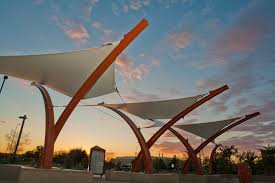Considering Different Types Of Shade Structure
5 min read
The type of shade structure/canopies you intend to use is among the most crucial factors. Shade structures come in a variety of forms for architects and landscape architects to think about. This choice is influenced by a variety of factors, such as available space and aesthetic preferences.
As you organize the construction of your shade structure, consider the following popular varieties of canopies:
1. Shade Sails
One of the best types of shade structures are commercial shade sails, which provide creative flair to any kind of commercial space. This shade structure offers great versatility with its three-, four-, and five-point versions. To maximize sun protection, you can place a single, huge sail exactly where you need it or arrange several shade sails in a pattern.
To produce a beautiful appearance and the appropriate amount of shade coverage, you may also adjust the height of the shade sail columns and cloth attachment points. Additionally, these structures provide a lot of room below, which gives you a lot of venue design alternatives.
Shade sails keep the open space perfect for playgrounds, swimming pools, building entrances, and other outdoor areas.
2. Cantilever
Cantilever shade structures have horizontal supports and one or two columns supporting them on one side. Because fewer vertical supports are required, this design makes greater space underneath the building possible. Aluminum canopies work best in these cases. When it comes to sections that require clear space below, such as parking lots, sidewalks, bus stops, bleachers, or other sitting areas, cantilever buildings offer you more choice.
Compared to shade sails, cantilever structures provide much more design possibilities. This canopy is ideal for twisted shade textiles and artistic roof designs. For instance, the Hip
T-Cantilever has a more straightforward form with extensive shade covering, whilst the Aquarius cantilever structure has a curved canopy.
Cantilever discs and single post pyramids are two examples of the distinctive minimalist designs produced by single-post cantilever constructions.
3. Outdoor Shade Structures
Even while the majority of shade structure types are quite adaptable, some may work better for your project than others. Outdoor pickup shade structures have become more and more popular among stores and other commercial places as contactless purchasing has increased.
Customers and employees may easily get shade from the sun under these structures.
On hot days, outdoor shade structures let patrons stay cool in their cars while waiters deliver their orders. Outdoor shade structures are reusable and contribute to the color and style consistency of your brand.
Outdoor shade structure installations can accommodate a variety of shade structure types, such as:
Tri-truss cantilever: This kind of cantilever construction has adequate room underneath it to hold client automobiles. In a parking lot, the tri-truss cantilever’s double-wide or connected versions can also offer enough shade for several automobiles.
Arch-truss: The arch-truss shade structure has columns on one side and a curved roof. Cars can park in the shade below or pass through with ease thanks to this arrangement. There are connected and double-wide versions of the arch-truss as well.
Slanted cantilever wing framed: The roof of this shade structure slopes from front to back, giving it a distinctive design and lots of shade for patrons and employees alike. For even additional shade, choose the double-wide or connected variants from the slanted cantilever wing-framed construction.
You should make sure that everyone who needs shade has access to it, regardless of the shade structure you decide on for the outdoor pickup area of your project.
4. Scholarshade Systems
An unique shade structure design may be required for playgrounds, daycare centers, schools, and other childcare facilities. While some schools are seeking ways to make social isolation while outside simpler, many are required to achieve a certain shade requirement in order to maintain their accreditation. Schools can benefit greatly from shade structures.
Playgrounds and other outdoor learning spaces require shade, particularly in places with strong sun exposure. When enjoying the outdoors for recess, physical education, and after-school activities, students need to be properly protected.
Schools can benefit from shade structures in the following ways:
- a) Sun protection for children as they play: Young children in daycare or preschool may not be able to identify when they are too hot. Shade structures for daycares and early childhood centers provide peace of mind for parents and safeguard small hands.
- b) Shade that works well for older children: Although middle and high school students often spend less time on the playground, there are still areas of the school where shade is useful, such as outdoor cafeterias, walkways, and bleachers. Use shade structures to make these spaces more contemporary and pleasant.
- c) Creating a marketing appeal for prospective students: Educational institutions consistently look for methods to differentiate themselves from the competition. University shade structures are a great addition. Adding shade improves a college’s outdoor space’s usefulness and produces a distinctive visual style.
- d) Relief from the heat in trade schools: A shade structure distinguishes the school and shields pupils from damaging UV rays in outdoor learning areas. Shade structures can also be used by trade and commercial schools to expand usable space or to cover places where people currently congregate.
5. Aquatic Treatment Center Shade Layers
Shade structures can offer the necessary shade for industrial facilities, protecting equipment and guaranteeing regulatory compliance. For instance, in order to preserve water purity and equipment functionality, municipalities and local governments frequently need shade at water treatment plants.
Equipment used in the treatment of water and wastewater, such as tanks, pumps, and storage facilities, can be harmed by prolonged sun exposure. Additionally, water in the tanks may evaporate due to solar radiation, which could lead to an imbalance in the chemical level of treatment and ineffective functioning. Shade structures give this important procedure the necessary shade.
In Brief
Aluminum canopies are the ultimate of architectural form and usage due to their timeless beauty and remarkable utility. Their significance to modern designing is established by their ability to blend in seamlessly with a variety of surroundings, all the while providing durability, sustainability, and aesthetic appeal.
These canopies prove the continuous attraction of aluminum in architectural design, whether they are beautifying the front doors of a business or offering shade in a public park.







